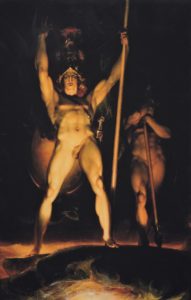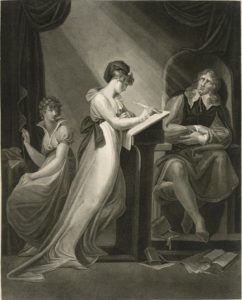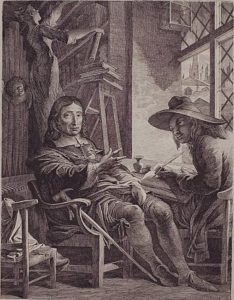The Satanic Scholar’s Iconography page has recently undergone a massive overhaul, and now includes not only Romantic art but proto- and post-Romantic art as well, each subpage featuring a thorough cultural context, extensive biographical information about the artists, and informative commentary on their Miltonic illustrations.
Click here to see the Proto-Romantic Art.
Click here to see the Romantic Art.
Click here to see the Post-Romantic Art.

A review of the Satanic iconography linked to above gives one an appreciation of what Romanticism’s Miltonic illustrators produced, which was nothing less than the pictorial apotheosis of Milton’s fallen archangel Satan—and, it must be said, the most accurate portrayal of the majestic arch-rebel who curiously holds pride of place in Paradise Lost. “As to the Devil he owes everything to Milton,” observed Percy Bysshe Shelley in his unpublished Essay on the Devil and Devils (ca. 1819–20), for “Milton divested him of a sting, hoofs, and horns, clothed him with the sublime grandeur of a graceful but tremendous spirit—and restored him to the society.” This Miltonic makeover of Satan as fallen Lucifer—a magnificent figure whose “form had yet not lost / All her Original brightness, nor appear’d / Less than Arch-Angel ruin’d” (I.591–93)—is precisely what Romantic artists executed as they brought the princely rebel angel to life. The Romantic Satan is heroically human, his form—almost always angel-winged, if not wingless and fully humanized—titanic in stature, his face Apollonian in beauty, with due emphasis on Milton’s description of “Eyes / That sparkling blaz’d” beneath “Brows / Of dauntless courage, and considerate Pride…” (I.193–94, 602–3). As Romantic Satanic artwork discards traditional Christian iconography in favor of Milton’s poetry, long gone are the bestial horns and hoofs and general grotesquerie of medievalism; the Miltonic Satan of Romanticism is clothed in a splendor befitting a Grecian god.
The importance of the images of Satan which appear across Romanticism’s Miltonic iconography simply cannot be overstated. Those who never venture to read Paradise Lost’s more than ten thousand lines of verse (“None ever wished it longer,” Samuel Johnson famously remarked) or the Romantics’ extensive critique of Milton’s epic poem, to say nothing of their own Satanic poetry and prose, can still comprehend the Miltonic-Romantic legacy of Lucifer simply by surveying the abundant sketches, paintings, and engravings of Romantic illustrators of Milton. Gazing upon the Romantic Satan is the simplest way to register just how illustrious Lucifer was during Romanticism—but to also understand that, as Shelley duly noted, the Devil is indebted not so much to the Romantics as to Milton, whose Paradise Lost invited—or rather insisted upon—such a reimagining.
— Christopher J. C.

